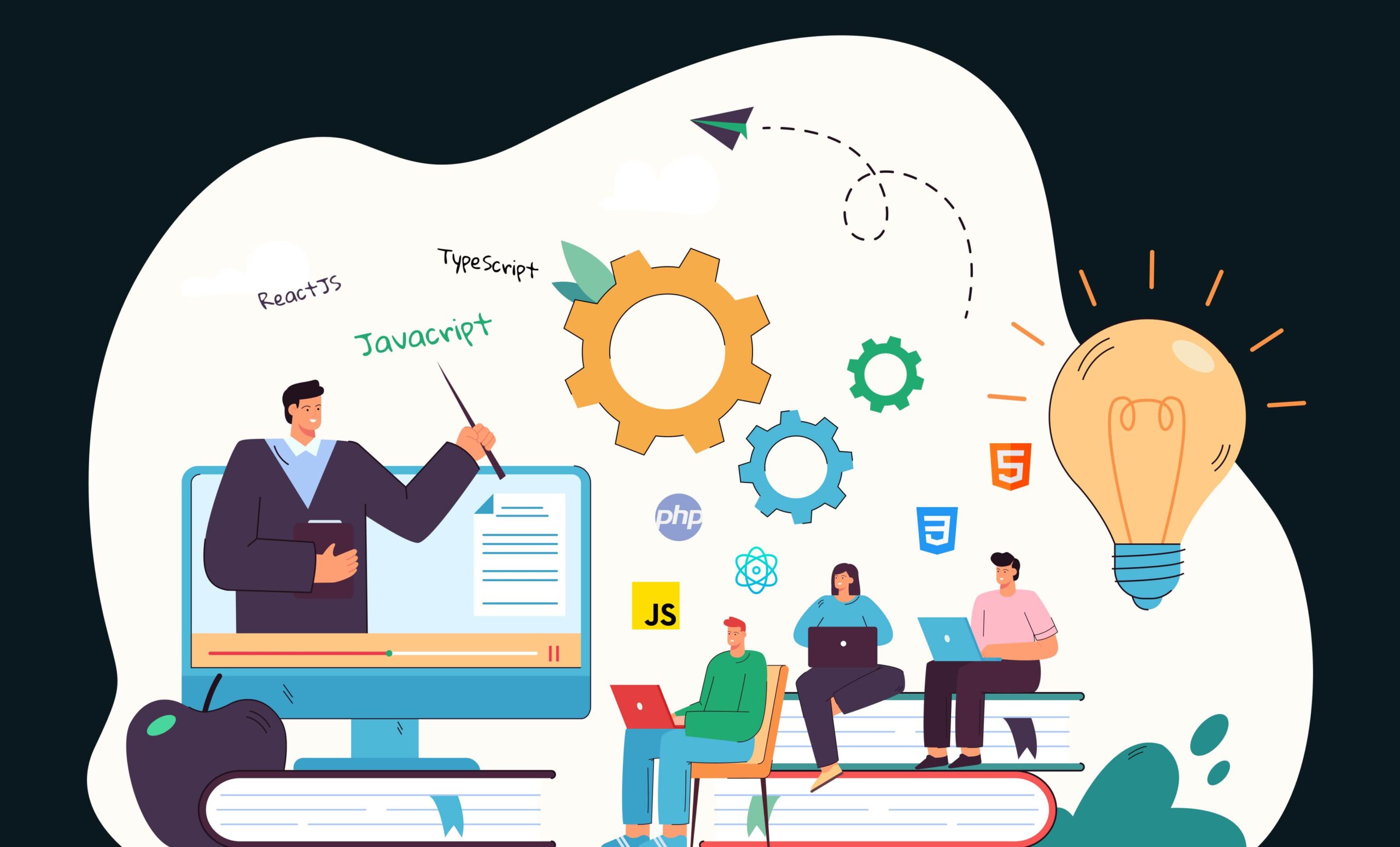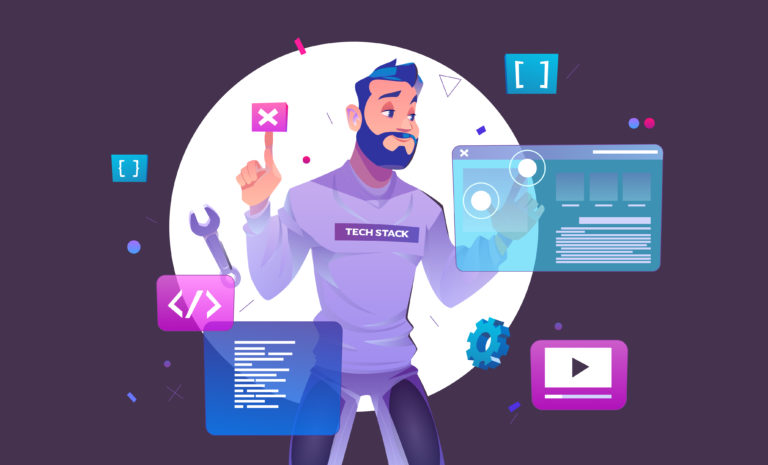What Does “A Tech Stack” Mean?
A group of technologies used to create software projects is known as a “tech stack,” which is made up of a collection of tools, frameworks, libraries, third-party software, and programming languages used by developers.
Client-side and server-side, commonly referred to as front-end and back-end, are the two basic and most important components of software that make up an application. The aforementioned features are used to build each layer of an application, forming a stack.
- The FRONT-END is the user interface, which lets users communicate with it. Its major goal is to make using it convenient and pleasurable.
- The BACK-END makes sure that all functionalities are working properly and responds to user queries. It comprises operating systems, databases, APIs, server-side frameworks, and programming languages. The back-end also includes hosting, deployments, and business logic.
- MIDDLEWARE connects the front-end and back-end by acting as a covert translation layer; it is not a development tool. Middleware integrates two or more frameworks, programs, or parts to make communication easier. It includes technologies that assist app creation and distribution, such as app servers, web servers, content management systems, and other related tools.
How Can You Pick a Technology Stack?
Many different front-end and back-end technologies are available. Although JavaScript is frequently used for front-end development, other frameworks like Angular, React.JS, and Vue.JS are also becoming more popular. Java and.Net are frequently used as examples for back-end development, a wide range of alternative programming languages and frameworks are also available, including PHP, Ruby on Rails, Python, C++, C#, and others.
Different development stacks might be needed for various projects. While new, cutting-edge technologies might not have the required functionality or support, time-proven technologies might not be the best option for all tasks.
Let’s have a look at the most frequently utilized technologies for various project categories:
For Web Applications Development
JavaScript is frequently used as a scripting language to add interaction to online sites. To enhance user interface capabilities, a variety of JavaScript libraries, including jQuery, Bootstrap, and Slick, are integrated into frameworks like Angular, Vue.js, and React.js.
HTML is used to create and place content. HTML is used to position and arrange every element on a page.
While CSS is used to format structured material, HTML is used to organize content. This mostly refers to the use of fonts, colors, layout components, background material, etc.
For Mobile Application Development
Mobile technologies can be classified as cross-platform, hybrid, or native. The foundation of native app development is the use of native programming languages, such as Swift and Objective-C for iOS, and Java and Kotlin for Android.
Whereas, the foundation of hybrid development is the usage of tools like HTML5, JavaScript, Ionic, Cordova, PhoneGap, and Xamarin.
React Native, Xamarin, and Flutter are the frameworks most frequently used for cross-platform development.
Today, using a native mobile app development strategy is much more preferred due to the increased control and simpler hardware access it offers.
In any case, the technology used should improve application speed while enabling your development team to manage the product’s codebase and iterate more quickly.
IMPORTANT ASPECTS FOR CHOOSING THE RIGHT TECH STACK:
As we have now given you a sneak peek into the technologies related to various project categories, we can now focus on the five factors to think about when selecting a tech stack for your project. There are quite a few important aspects to take into account in order to swiftly reduce the available possibilities.
- Personal Prerequisites:
The technology you chose must be dependent on the issue you’re trying to resolve. When it comes to large-scale projects requiring intricate business logic and platform-independent code that must function consistently, Java excels above other languages.
Users’ requirements should be considered when developing apps. Consider who will be using your app and how to provide them with a fantastic user experience. Before enhancing performance with your own infrastructure, if you want to join the market fast, you may start with a ready-made environment in which to deploy your code and applications. When you have a tiny user base, it is unreasonable to invest a lot of time and money, but after you pass the necessary size level, you can begin to consider performance.
- Project Scope
Smaller projects may often be completed more quickly and without the need for complex frameworks and technology. You might need to rapidly create a minimal viable product (MVP), show it to the client, and solicit insightful feedback. To accomplish that, you might make use of open-source software and basic tools.
There is a higher level of technology participation for mid-size projects. They could require a mix of several programming languages and frameworks, depending on the requirements. Such initiatives need more sophisticated technology that can supply more complex features.
As many functionalities, interconnections, and higher levels of security and sophistication are required, complex systems like ERP systems, social networks like Facebook, and online marketplaces like Amazon and ERP systems are constructed using a wide range of programming languages and frameworks.
- Time to Market:
A minimal viable product is a fantastic choice when you need to start your project as quickly as possible. To cut down on the time you need to spend getting ready to enter the market, you could wish to start with ready-made solutions. For instance, the Ruby on Rails framework, which offers access to a number of fundamental libraries, can help you save a lot of time.
Through third-party connectors, you may expand the functionality of your app without starting from scratch and wasting time looking for developers. Additionally, well-documented technology might make it much easier to design particular functionalities.
- Scalability :
Don’t forget that the tech stack you employ ought to have the ability to scale effectively if you anticipate significant expansion. Every tech stack might not have the capability to scale well. You may expand your app either horizontally by adding additional physical machines or processing units to your server, or vertically by adding new features.
- Safety:
It is essential to guarantee that the app was created with the finest security and threat mitigation methods in mind. You might need to do security checks on both the client and server sides to eliminate typical security vulnerabilities. Before beginning the development process, you should carefully analyze your choice of technology because not all of them are equally safe.
The Bottom Line:
Different online and mobile applications demand various development tools. There isn’t a standardized, efficient technological stack, which is unfortunate. You must first take into consideration your project’s needs while selecting a technological stack. Time-tested technologies can not always be sufficient since you need to be realistic and consider each technology’s advantages and disadvantages. At zenkoders, our team of knowledgable and experienced developers can assist you in determining the project’s needs and make recommendations for the best technologies to use in order to create a scalable and highly functioning app that will outperform the competition.


